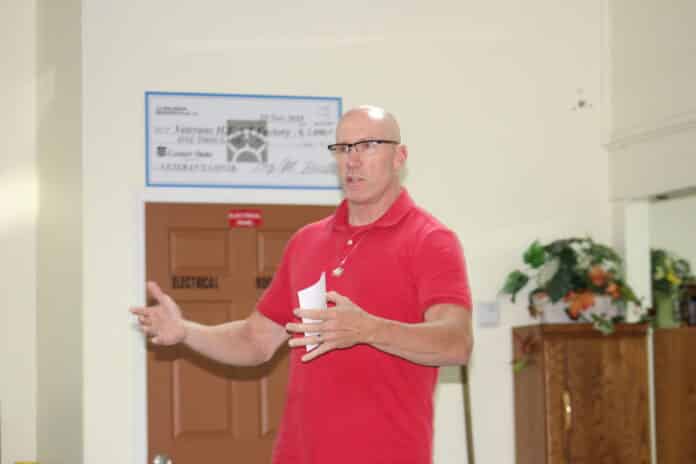By LISA MACNEIL
Hernando Sun Reporter
Post Traumatic Stress Disorder (PTSD) is commonly thought to affect military veterans, especially those close to combat situations. Not often is PTSD associated with law enforcement and other first responders, medical personnel, or even emergency dispatch personnel.
Former Major Crimes Detective Cole Brinson put this into perfect perspective, in his case, law enforcement. “Here we are, you’ve got the same bullets flying by you. You get hit by them sometimes. (We) deal with death…”
Brinson found the HEAT Factory not very long after what he described as a “complete mental breakdown” in 2017, which ended his career. Today, with his wife by his side, Brinson credits the organization with welcoming him and his entire family with open arms, and helping him in recovery after his symptoms were recognized.
Founded in 2017 by School Board member and business leader Gus Guadagnino, the Veterans’ HEAT Factory is a local non-profit organization that makes a point of providing resources to all sufferers of PTSD. HEAT is an acronym for what the organization provides its members: Honor, Empower(ment), Assisting and Training.
In a Lunch-and-Learn training session held on April 27, 2019, attendees learned of new therapies holding a lot of promise to minimize PTSD symptoms, even in long-time sufferers. Licensed Mental Health Counselor John Cothron of Work It Out Counseling, based in Clermont, FL introduced the group to Accelerated Resolution Therapy (ART) and Reconsolidation of Traumatic Memories (RTM), two new approaches to treating stress from traumatic events.
Cothron reports both show a 90% long-term success rate.
An Army Veteran with a 20-year career on his resume, Cothron spoke to the group about the manifestations of PTSD and its many causes. “It doesn’t mean that the event has to happen to you… you can see some gruesome stuff out there.”
An older PTSD treatment technique called Eye Movement Desensitization and Reconsolidation (EMDR) paved the way for ART. According to Cothron, EMDR is not effective for everyone and can take up to a year to see results. ART, however promises better results, faster.
Eye movements are integral to ART. A therapist performs hand motions, which the participant follows with their eyes, while recalling the traumatic event. The therapist then watches for a visible reaction from the participant. Sometimes, there will not be a visible reaction, and the therapist asks the participant to describe their emotional state while recalling the event. During this phase, the therapist then redirects the participant to focus on the reaction and not the event. With repetition, the anxiety reaction is reduced to a manageable level.
A relaxation phase follows, which participants can practice alone. The eye movement phase should only be attempted with assistance.
This approach is helpful when preparing for future events that might elicit a stress reaction. It essentially trains the brain; “When this happens, this is what I need to do… it’s opening up the brain to start re-learning how to process things properly.”
Cothron reported that one participant who slept no more than three hours a night was able to sleep for seven hours after the first ART session.
Reconsolidation of Traumatic Memories (RTM) does not involve eye movement, however does involve visualization. Cothron explained, “You dissociate three levels from the event. Level one, you’re going to imagine the event from, say, sitting in a movie theatre.” Under the therapist’s guidance, the participant visualizes being in the theatre, seeing the traumatic event on the screen as a black and white movie. Level two is the participant sitting in the chair, watching the event at a distance. Level three moves further away, perhaps to the projection booth, watching the event from an even greater distance.
He cautioned, “Unless sitting in a theatre is not safe for you.” Then an alternative visualization is planned.
The final phase of these visualizations has the participant stepping into the movie, which is in full color, and rewind rapidly. Re-scripting follows, where the participant essentially rewrites the movie with a more acceptable outcome.
Cothron summarized the effectiveness of both methods as, “Teaching the brain how to handle the stress.”
RTM appeared in the Journal of Experiential Psychotherapy (Vol. 20, No. 4 (80) December 2017). The article describes a case where a participant completed three 120 minute sessions of RTM, resulting in reduced PTSD symptoms in follow-ups from 2 weeks to one year later. The participant in the study was a Vietnam era Veteran, who experienced symptoms for more than 40 years prior to treatment.
A USA-funded British study concluded very recently that, “The ART protocol aligns closely with established first-line trauma-focused psychotherapies and clinical guidelines. It appears to provide frequent clinical relief of symptoms of PTSD in an average of four sessions among military personnel with challenging clinical (symptoms), including (PTSD with) TBI (traumatic brain injury) and extensive operational combat-related trauma.” Trauma Focused Therapies (Volume 19, Issue 2 June 2019)
More info:
Veterans’ HEAT Website: www.veteransheatfactory.com
Work It Out Counseling: www.workitoutmhcounseling.com

